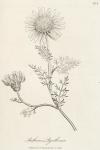
 Synonyma. Pyrethrum. Pharm. Lond. & Edinb.
Synonyma. Pyrethrum. Pharm. Lond. & Edinb.
Pyrethrum flore bellidis. Bauh. Pin. p. 148.
Pyrethrum officinarum. Lob. 447. Gerard Emac. p. 758. Park. Theat. p. 858. Raii. Hist. p. 353.
Chamaemelum specioso flore, radice longa fervida. Shaw, Afr. p. 138.
Anthemis caulibus simplicibus unifloris decumbentibus. Mill. Fig. t. 38.
(greek) Dioscorid. Lib. 3. c. 85. [Ab igne nomen habet, ob radicis ejus fervorem igneum. V. Bauh. l. c.]
Class Syngenesia. Ord. Polygamia Superflua, Lin. Gen. Plant. 970.
Ess. Gen. Ch. Recept. paleaceum. Pappus nullus. Cal. hemisphaericus, subaequalis. Flosculi radii plures quam 5.
Spec. Char. A. caulibus simplicibus unifloris decumbentibus, foliis pinnato-multifidis.
The root is perennial, tapering, long, externally whitish, and sends off several small fibres: the stems are usually simple, round, trailing, bearing one flower, and scarcely a foot in height; but the specimen here figured was extremely luxuriant, and has in some degree departed from its more common and simple appearance: the leaves are doubly pinnated, segments narrow, nearly linear, and of a pale green colour: the flowers are large, at the disc of a yellow colour, at the radius white on the upper side, on the under side of a purple colour: the different florets answer to the description given of the Anthemis nobilis. It flowers in June and July.
This plant is a native of the Levant and the southern parts of Europe; it was cultivated in England by Lobel in 1570, [Adver. p. 346. Vide Hort. Kew.] but it does not ripen its seeds here unless the season proves very warm and dry. [Miller Dict.] The root of Pyrethrum has a very hot pungent taste, without any sensible smell. "Its pungency resides in a resinous matter, of the more fixed kind; being extracted completely by rectified spirit, and only in small part by water; and not being carried off, in evaporation or distillation by either menstruum." [Lewis M. M. p. 527.]
The ancient Romans, we are told, employed this root as a pickle, [See Berg. M. M. p. 698.] and indeed it seems less acrid than many other substances now used for this purpose. In its recent state this root is not so pungent as when dried, yet if applied to the skin it is said to act like the bark of mezerion, and in four days produces inflammation of the part. [Bergius, V. l. c.]
From the aromatic and stimulating qualities of Pyrethrum there can be no doubt but that it might be found an efficacious remedy, and equally fitted for an internal medicine, as many others of this class now constantly prescribed. Its use however has been long confined to that of a masticatory, [Its use in this way is mentioned by Serenus Samonicus. "Purgatur cerebrum mama radice pyrethri."] for on being chewed, or long retained in the mouth, it excites a glowing heat, stimulates the excretories of saliva, and thereby produces a discharge, which has been found to relieve toothachs, and rheumatic affections of the face; in this way too, it is recommended in lethargic complaints, and paralyses of the tongue.

